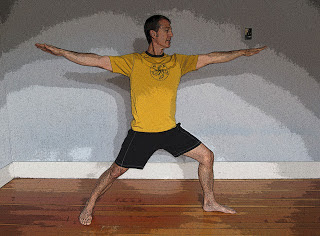by Ram
 |
| Happy, Healthy Warrior Pose |
Recently William Broad, author of The Science of Yoga, wrote an article in the New York Times Wounded Warrior Pose, which claimed that yoga is “remarkably dangerous” for men. While this article is a must read for folks who practice yoga asanas (practitioners, teachers in training or students), there are several important issues mentioned in the article that needs to be properly understood and clarified.
Let’s start by clarifying for the benefit of practitioners and non-practitioners: the main reference throughout the article is to yoga asanas and not yoga per se. While this seem trivial, it is very important because one can resort to other yoga activities like dharana (focus), dhyana (meditation), pranayama (regulated breathing) and sustain very minimal if no injuries. Also, yoga is not a competitive sport; for more on this kindly refer to BKS Iyengar’s book Light on Yoga.
While it may seem that the practice of yoga asana is largely a feminine pursuit, such gender inequalities exist in several other sports and training programs. We do not see a mainstream ladies equivalent of American football, the zumba and pilates classes in the gym that I go to is dominated by females and it is mostly men that are busy working out their “ceps and packs” in the weight lift arena. Uncoordinated or improper movements can put an individual at risk and subsequent injury in any sport or training program. The same is true for yoga asanas, which require coordinated movements of several areas/parts of the body.
William Broad acquired medical data, performed a non-scientific partial analysis and concluded that gender differences in yoga injuries exist and men are at most risk for these types of injuries. To me it seems that the differences could be explained at least in part by differences in the amount of training and asana practice.
Retrospective training/sport injury studies have to be normalized (a suitable denominator has to be factored in). Typically, total exposure time in hours or months or years have to be factored in to draw a reasonable conclusion. In a retrospective 12-month scientific study reported by a group in Finland and published in the 2009 issue of Journal of Sports Science and Medicine, the authors concluded that after combining all reported acute injuries sustained by cross-country skiers, swimmers, long-distance runners and soccer players, no significant difference was observed in such injuries when calculated per 1000 exposure hours.
Similarly, another study comparing sports injuries in men and women that was reported by a group of family practitioners from Kaiser Permanente found no statistically significant gender difference for injuries per 100 participant-years (Sallis et al; Int J Sports Med. 2001 Aug;22(6):420-3. Comparing sports injuries in men and women).
If proper scientific standards were applied to Broad’s yoga analysis, it would mean factoring in the mean exposure hours of yoga asanas performed. Based on the above studies my gut feeling is that no gender differences would similarly be found in injuries sustained from yoga asanas.
So do not be put off by Broad’s article! Remember yoga philosophy, which includes asana practice as well, does not discriminate between estrogen and testosterone. The major component of the practice is about “letting go” of the ego, including your body image, and finding your true self. So focus on yourself and your personal practice. And focus less on a “macho” body and more on achieving stability, mobility and encouraging integration—gently coaxing all the muscles that are tight from sports and weight training to move and work together. Pay close attention to connections—between one part of the body and another, between thought and action and between breath and movement. Moving with this awareness helps in reducing risks from any serious injuries.
Follow Yoga for Healthy Aging on Facebook ° To order Yoga for Healthy Aging: A Guide to Lifelong Well-Being, go to Amazon, Shambhala, Indie Bound or your local bookstore.


I'm 66 and will not give up doing head stands and shoulder stands. My advice is to find an certified Iyengar teacher.
When I read Broad's NYT article, I took it on face value and concluded that men are definitely at risk until I came across Rao's analysis. The Dr has clearly explained the reasons why he thinks Yoga is safe to all and unsafe if you don't follow the guidelines irrespective of your gender status. Thanks Dr for your great analysis. Interestingly, I see pictures of men doing various asana poses on cliffs, steep canyons, hanging bridges and other dangerous terrains. It's like the men folk are calling out to Danger "Bring it on". The risk is there in every sport (gymnastics, ballet, diving and so on) irrespective of the gender. And so is true for Yoga as well.
Why is William Broad picking on Yoga which to me is the safest of the sport (excuse me for classifying it this manner)? I bet Broad is having issues with his poses maybe inversions and his fellow female participants are nimble and safe at it. So our man’s yogic ego is deeply deflated and what better way to fame than simply faulting the very sport. If he has to pick on injuries someone needs to remind him to focus attention on contact games like football or boxing. His tale will be more convincing.
I've been practicing yoga for a year, about 5 times a week (I'm recently retired and finding yoga is becoming my new love/addiction…) and I have to remind myself on a regular basis that yoga is not a competitive sport and although I am one of those type A set goals and find ways to achieve them, yoga has softened that attitude. But I do like hearing Ram's advice to focus on the flow and the mind-body connection and not how far can I get into a twist as compared to last week.
A few months ago I lamented to one of my instructors that I didn't feel like I wasn't making enough progress. She responded with the question, "Compared to what?" I had no real answer but it did make me reflect upon her words and I started to accept this is a journey, not a competitive arena.
My point is I think men can do yoga but as suggested by others, make sure you have a capable instructor(s) who offer multiple ways of doing any pose. And there is a definite difference between getting to your edge compared getting to a point of hurt and pain.
Having read Mr Broad's book and article in the NY Times, I appreciate him wanting to have a conversation regarding yoga. Nothing wrong with that idea.
Mr. Broad is most likely one of the many modern practitioners who believes that Yoga is exercise when in reality it is merely one small part of the total package. He evidently has missed the real meaning of Yoga; i.e. to focus (yoke) the mind, body and spirit by practicing Patanjali's 8 limb path (Yamas, Niyamas, Asana, Pranayama, Pratyahara, Dharana, Dhyana, and Samadhi). In practicing Asana we are taught to leave our ego and competitiveness at the door. I believe the statistics he has used for reference most likely have come from practitioners who participate in performance or competitive forms and positions that many think are Yoga but are not. A good yoga teacher would never 'force' a student into a position that compromises or endangers the body. We are encouraged to find our own individual edge, then back off slightly (a micro-movement) and never go beyond that edge to the point of pain. The concept of 'no pain, no gain' does not apply here!
Yoga for me begins in my heart, which allows me to flow my energy (prana) into a comfortable physical form (asana) that provides an ability to focus inward.
Yoga is not an exercise regimen, although I believe a good portion of the public and some pratitioners see it as such, including Mr. Broad!
DON